Menus
- Cruise: five cruisers in the test
- Cruiser manners
- Lots of steam, little sound?
- Chassis and driving experience
- Ergonomics and conclusion
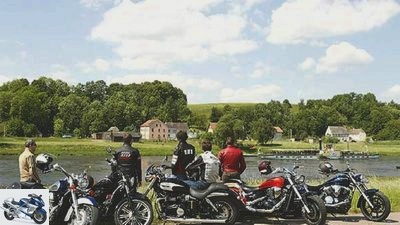
Bilski
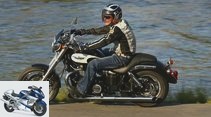
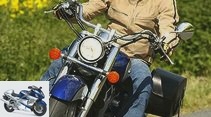
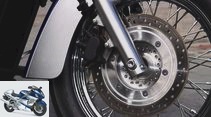
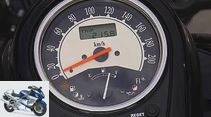
45 photos
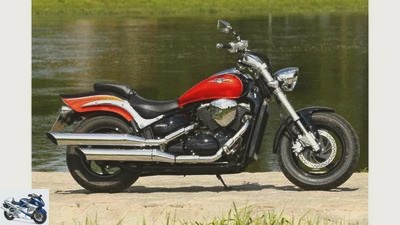
Bilski
1/45
… Suzuki Intruder M 800 Z, …
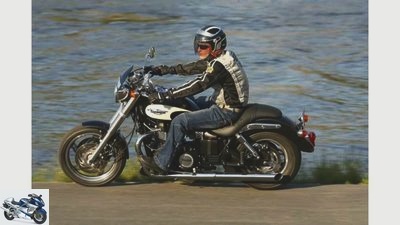
Bilski
2/45
The Triumph has the best chassis in comparison, but not everything about it is perfect either. The struts are stubborn and the fork springs pretty much bend when braking.
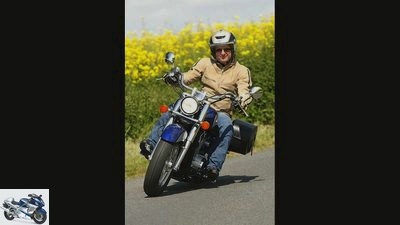
Bilski
3/45
The Honda is the cheapest in the quintet. It costs only 7440 euros. The two-tone paintwork and the panniers cost extra.
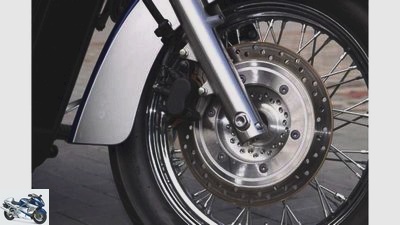
Bilski
4/45
So and so: weak disc brake meets beautiful spoked wheel.

Bilski
5/45
Black and white: the complete set of instruments is summarized in the console on the tank. Also on board is a very accurate fuel gauge.

Bilski
6/45
The Yamaha has only one exhaust and is driven by a toothed belt.
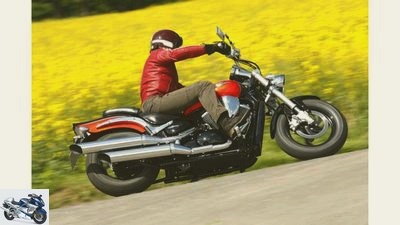
Bilski
7/45
The handling of the Intruder is disappointing. There is a lack of steering precision and stability. The shock absorber is overdamped and responds insensitively.
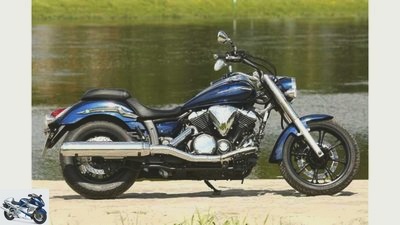
Bilski
8/45
… and Yamaha XVS 950 A Midnight Star.
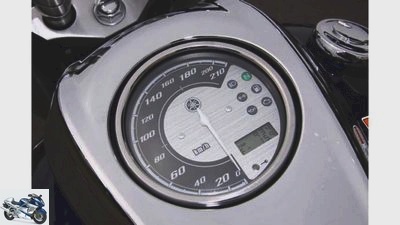
Bilski
9/45
Clean and classic at the Yamaha: Heavily nostalgic styled, this huge speedometer. The ignition lock sits in a small console above the headlight, as is customary.
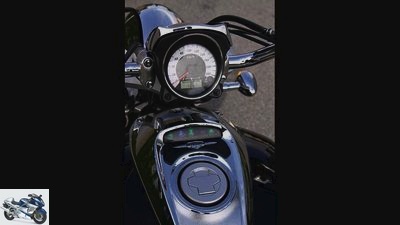
Bilski
10/45
Well thought out: The suspension above the handlebar clamp moves the speedometer further into the field of vision, the indicator lights sit separately on the tank.
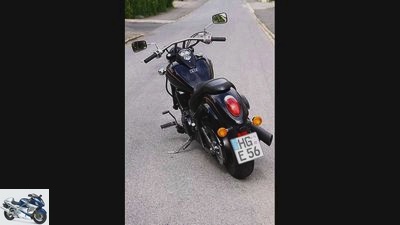
Bilski
11/45
The Kawasaki is a cool car. With worn rims, front car wheel, rear disk wheel, and tattoo-style decorations.
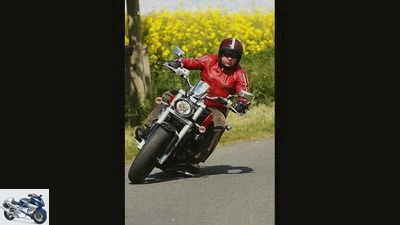
Bilski
12/45
The Suzuki is on par with the Kawasaki at 8250 euros.
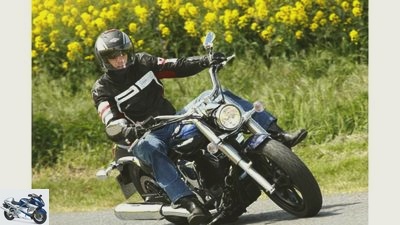
Bilski
13/45
At 8850 euros, the Yamaha is the most expensive machine in comparison. But for the money you also get the largest engine.
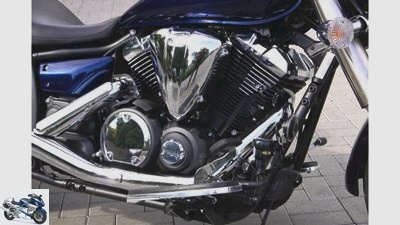
Bilski
14/45
New development: The 950 V2 rounds off Yamaha’s cruiser range at the bottom and dispenses with water cooling.
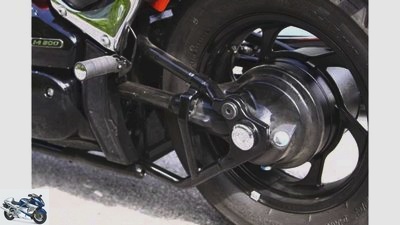
Bilski
15/45
The Suzuki swing arm also suggests a rigid frame to the viewer. Cardan drive.
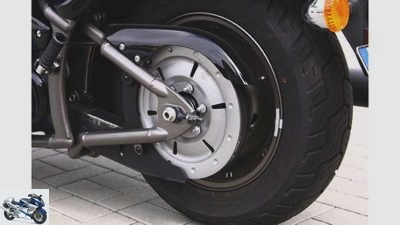
Bilski
16/45
Rear swing arm in rigid frame look and timing belt on the Kawasaki.
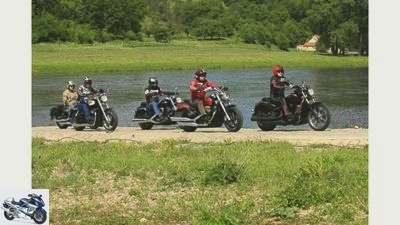
Bilski
17/45
MOTORRAD was on the road with five mid-range cruisers to bring out their strengths and weaknesses.
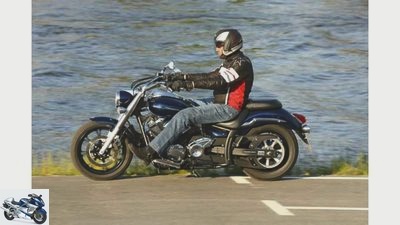
Bilski
18/45
The Yamaha chassis is on par with the Kawasaki. The lean angle is the least with her because of the sweeping running boards.

Bilski
19/45
Appropriate: weak brake and unadorned black cast wheel on the Yamaha.
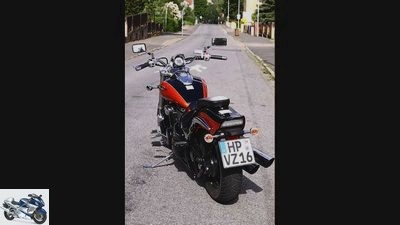
Bilski
20/45
The Suzuki has the best handlebars in the test field. The sitting posture is absolutely relaxed and the driver is well integrated into the Trude.
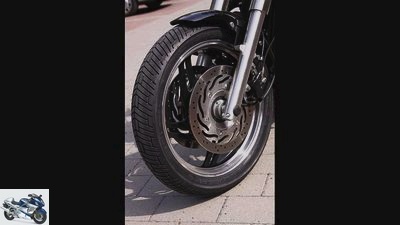
Bilski
21/45
The Triumph is the only machine with a double disc on the front brake. It also has polished wheel rims and a cranked valve.
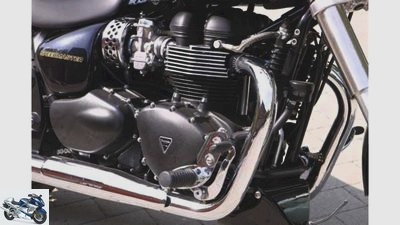
Bilski
22/45
Dancing out or in line: The only in-line twin wears an injection disguised as a carburetor.

Bilski
23/45
The cruisers stand out in addition to their casual look …
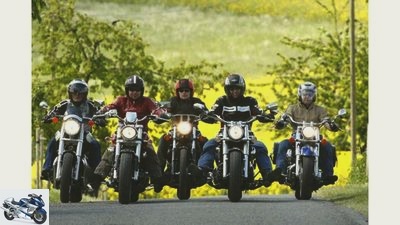
Bilski
24/45
The following machines were compared.
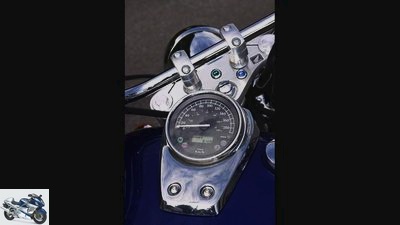
Bilski
25/45
Two-room apartment: With the Shadow, the control lights are located both in the neat upper fork bridge and in the speedometer. It also has a mileage scale.
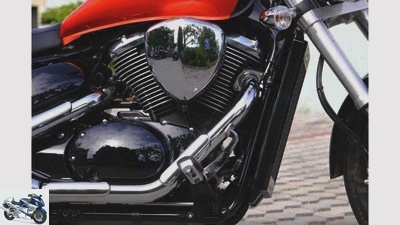
Bilski
26/45
It’s always been there: the true-to-style 45-degree V2 was born in 1986 as a 750 with just a little less drilling.
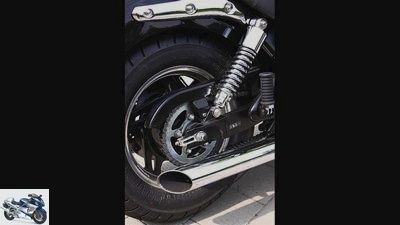
Bilski
27/45
The Triumph is the only one powered by a chain in the comparison. Another unique selling point are the mufflers on the right and left.
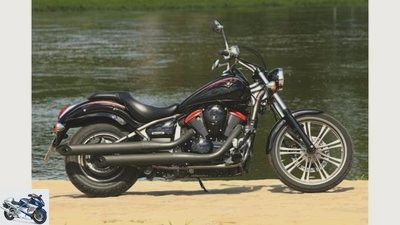
Bilski
28/45
… Kawasaki VN 900 Custom, …
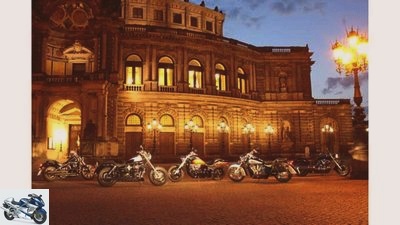
Bilski
29/45
The Triumph won ahead of the Kawasaki and the Yamaha. In fourth and fifth place: the Suzuki ahead of the Honda.

Bilski
30/45
… also with impeccable handling?
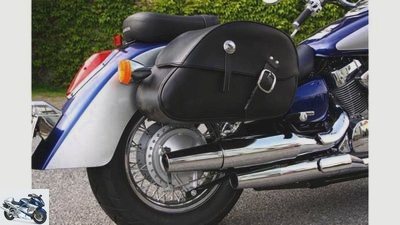
Bilski
31/45
Double pipe exhaust and cardan on the Honda.
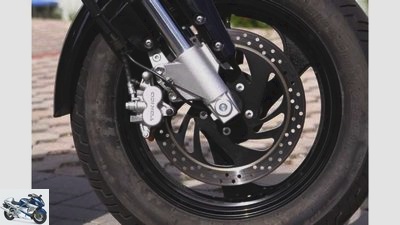
Bilski
32/45
The Suzuki’s upside-down fork is easy to twist and the brakes are overwhelmed.
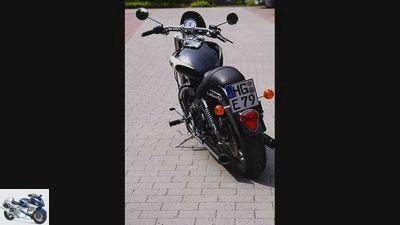
Bilski
33/45
The Triumph is the sportiest motorcycle in the cruiser test field. Historic brand emblems and hand-drawn decorative lines on the two-tone tank exude nostalgic flair.
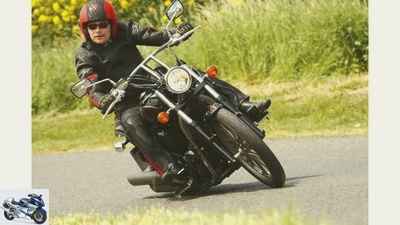
Bilski
34/45
The Kawasaki is available for 8,295 euros.
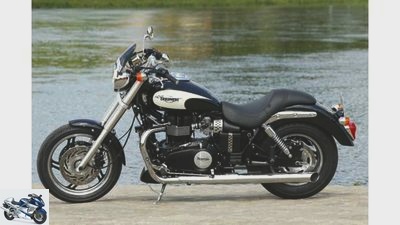
Bilski
35/45
… Triumph Speedmaster, …
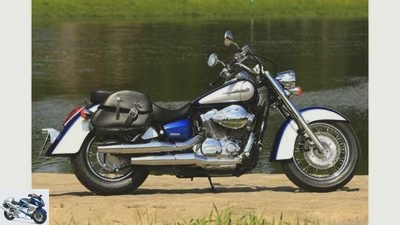
Bilski
36/45
Honda Shadow 750, …
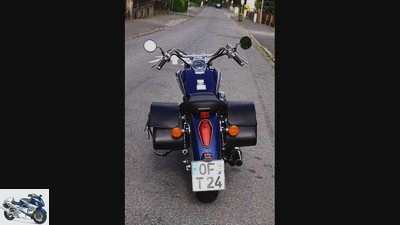
Bilski
37/45
The Honda is a petite motorcycle on which even riders from 1.70 meters seem out of place.
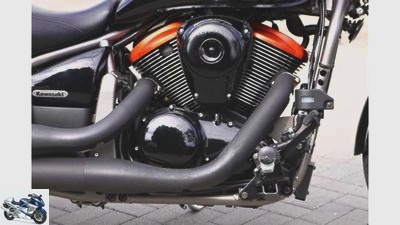
Bilski
38/45
Bigger is better: Longer stroke has pumped the 800 V2 introduced in 1994 to a good 900 cubic centimeters since 2006.
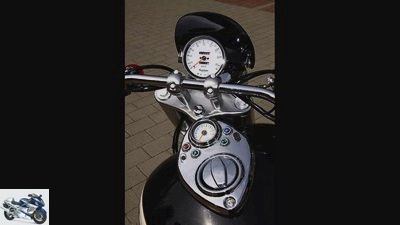
Bilski
39/45
Traditional: the kilometer counter works purely mechanically. There is a tachometer in front of the non-lockable fuel filler cap.
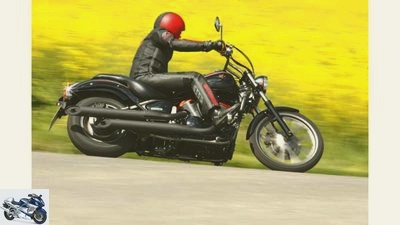
Bilski
40/45
The Kawasaki suspension elements have enough reserves when driving. It moves its course precisely and predictably.
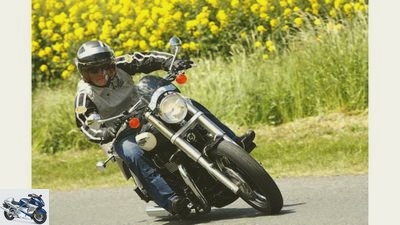
Bilski
41/45
The Triumph test motorcycle with tachometer, windshield and front spoiler costs 8958 euros, while the basic version is available for 8440 euros.
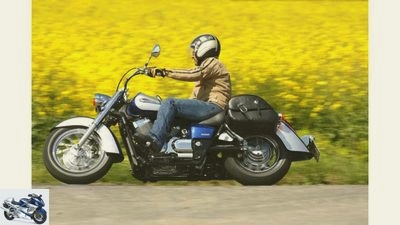
Bilski
42/45
The suspension of the Shadow works comfortably. However, the spring elements are quickly overwhelmed on poor terrain.
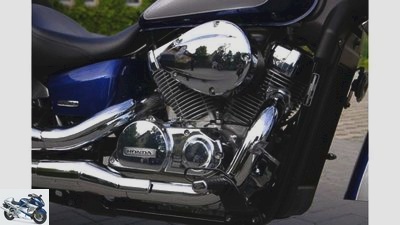
Bilski
43/45
Born to live forever: Honda’s indestructible V2 with three valves and a typical 52 degree cylinder angle.
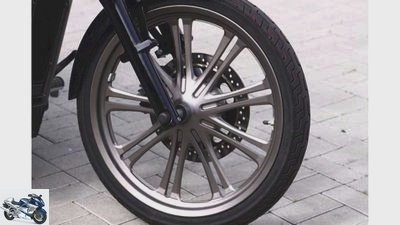
Bilski
44/45
The Kawasaki brake is mediocre, but the 21-inch wheel is an eye-catcher.
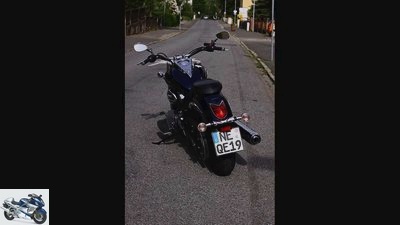
Bilski
45/45
Gear changes are only made using the rocker switch on the Yamaha. The sitting position is relaxed. The handlebar is extremely wide.
Comparison test middle class cruiser
Cruise: five cruisers in the test
Saxon steamship: We set off for a cruise with five machines that visually interpret the cruiser theme in very different ways. A comfortable journey between the oldest and largest still active paddle steamer fleet in the world and the mountains of Saxon Switzerland.
At first it’s just a distant pounding, then it grows into a deep, rhythmic rustle. A few seconds later, the paddle steamer Krippen passed us on the Elbe near Meiben with a deep thud. It was launched in 1892 and is one of the flagships of the Saxon steamship industry. In contrast, even the glowing appearance of the five cruisers parked between the bank and the “Saxon Wine Route” fades. Normally there is nowhere to stop unnoticed with this quintet. “The Saxon is more of a cozy guy,” the motorcycling hotelier explained that morning. So the five cruisers fit in perfectly here. Enjoy the rest, leave the hustle and bustle behind, don’t have to prove anything. Discover the country and its people comfortably. Overtake? What for? Just the good feeling, that has to be right. Honda Shadow 750, Kawasaki VN 900 Custom, Suzuki Intruder M 800 Z, Triumph S.peedmaster and Yamaha XVS 950 A Midnight Star invite you to live by the river, to live in the river. In harmony with yourself, the machine, the landscape. Wonderful when it thunders evenly left and right. Or front and rear with the four V-engines.
Buy complete article

Comparative test of the mid-range cruiser
Cruise: five cruisers in the test
Yamaha even weigh a whopping 280 kilos. Even if the five cruisers belong to the entry-level class, other standards apply on board these “light” cruisers. Although the buttocks are flat out in fat, deeply mounted saddles, nothing is beginner-friendly here. This also applies to turning, which hinders a protruding handlebar. And that requires wide roads. This can only be done in one go in the rarest of cases.
It’s just stupid when the front wheel of the Triumph folds down on its own in tight turns and at low speeds and you suddenly have to take corrective action if you want to prevent an accident. Done, all five lamps point in the right direction, heading south-east. Tiny, difficult to read indicator lights on all control stands lead to records in continuous flashing. So what? The smell of the bright yellow rapeseed fields makes up for such small nicknames. Full in the wind, “naked” as the Saxon would say, the passing nature is a special pleasure. Leaning back seating positions and open face helmets open up a great experience. In Dresden we admire the world-famous baroque panorama behind the Bruhl Terrace. And the steamships lying in front of the roadstead. Our fleet also looks back on a long tradition. The Honda Shadow 750, for example, casts a long shadow. Its ancestor appeared in 1986. As always, the 52-degree V2 drives it with three valves. There is plenty of chrome or chrome-plated plastic, polished aluminum and sparkling wire wheels as a garnish. Contrasts everything very finely with neat two-tone paint and, depending on your taste, the practical or embarrassing panniers for luggage transport for a total of 600 euros extra.
Cruiser manners
The Kawasaki VN 900 Custom can do without such insignia. Pure and puristic, it embodies the chopped way of life. With a super narrow, yet huge 21-inch wheel at the front. Here it shines dark and gloomy: air filter housing, lamp bell, the fork dip tubes, even the scratch-sensitive exhausts. Damn black, that Iron Horse. Your understatement comes across really well. Almost Harley-esque. For all those who like it baroque, Kawa has the VN 900 Classic up its sleeve, with the same 55-degree V2. Its predecessor, the VN 800, was presented in 1994. Suzuki’s first Intruder 750 was in the shop windows back in 1986. Back then, next to the 1400, the first real Japan chopper, stylish, slim and clean. Today the “intruder” is more expansive, longer and flatter. Plus with a minimal increase in displacement (803 instead of 745 cm³) and double ignition, but as usual with a classic 45 degree cylinder angle. Aunt Trude uses an upside-down fork, flowing shapes and an LED rear light in the bobtail tail on muscle bikes. And with the hidden strut, like Kawa and Yamaha, heavy on rigid frame optics.
The elegant Triumph proudly presents its shiny chrome-plated stereo struts. The Speedmaster is wirier, more muscular than its sister Bonneville America. The only double disc brake in this field emphasizes its sporty aspirations. Individual: the “Gunfighter” bench seat with a permanently docked, inconveniently sloping emergency seat for the passenger. Historic brand emblems and hand-drawn decorative lines on the two-color tank and its non-lockable cap exude nostalgic flair. The huge speedometer on the handlebar is reminiscent of classic Smiths watches. With the Triumph one likes to be seen. The posture behind the buffalo horn handlebars, which are enthroned on high risers and cranked down, is individual. Characteristic: the only row twin in the test field. Besides BMW, Triumph is the only large-scale manufacturer that completely dispenses with V-engines. A crankshaft with a 270 degree crank pin offset is supposed to imitate a V2 in sound and character. However, so much in advance, it only works to a limited extent. On the other hand, it is beautiful: the elongated line, characterized by the narrow, dead straight silencers, the only ones that are laid to port and starboard. The Japanese carry their two mufflers stacked on the right.
Lots of steam, little sound?
Wait a minute, the 950 Yamaha only exhausts through a tailpipe: muffled, dry and deep. Traditionally air-cooled, like the Triumph, are its cylinders, which are spread by 60 degrees. It is long and low. Stretched to the maximum, in terms of wheelbase and length. The sitting position with the extremely wide handlebars is relaxed. “Klonk”, knock test passed: only the XVS literally wears real mudguards, solid metal instead of plastic. Also exclusive to the Midnight Star: rocker switch and low-level running boards. “Klonk” can be heard from the gearbox, the worst of all. The gears do not lock exactly, can be shifted hard, hooked and stiff. Ironically, the motor giant with the longest stroke in the comparison does not deliver on the promise of a “push cart” with full pulling power and a lazy driving style. Put in the last gear once and then on and on, to the horizon and beyond forever … Well, below 60 km / h, the 950er shakes in the final fifth gear. The beariest engine is the most inelastic, the long overall transmission kills some of the powerful torque. Too bad. Ten years ago the XVS 1100 Drag Star was able to do this better, which incidentally also braked better. So here and now it’s time to shift down when driving around town. Just like now in Bad Schandau.
Off to Saxon Switzerland! Sandstone cliffs on the left, the river on the right. Above that, white fleecy clouds in the azure blue sky. Just no sound echo for the Triumph. If it drives past you, it’s still okay, for the captain himself it sounds like a sewing machine. Full four-bar beat? Forget it. In addition to the acoustics, the row twin lacks spirit. He has the highest performance, real 69 hp, and the greatest revving. And thus everything that a cruiser doesn’t really need. This motor is too short stroke, it does not kick. When the “Speedy” appeared in 2003, it had a displacement of 790 cm³, now it is 865. But the birth defect got worse when it was opened.
The widest pistons whiz up and down the shortest. The (optional) rev counter in front of the chest reports that the twin requires at least 3000 tours in the upper gears for proper concentricity, and can be squeezed out up to 8000 rpm if necessary. The gear changes on the ultra-long shift linkage need a little emphasis. English quirk: There are now injectors in the carburetor housings – Euro 3, but please with style. For a cold start you have to pull the choke on the “carburettor”, a cold start increase, otherwise the twin just spurts. English? Triumph now builds all (small) two-cylinder models in Thailand. After all, the finish is right, with the exception of rust in the fuel filler neck. The chain is maintenance-intensive, all others rely on clean, low-maintenance solutions: Cardan for Honda and Suzuki, timing belt for Yamaha and Kawasaki. In return, the brakes are only reasonably convincing on the Triumph. They snap almost too poisonously, compress the soft fork springs violently – thick ducts only give the impression of great stability.
Chassis and driving experience
On the driveway to the Bastei, a former mountain race track, the Speedmaster shows its greatest freedom of lean angle despite the somewhat stubborn suspension struts. But be careful, the side stand is on the left side first. When it comes to speed escapades, the Yamaha has long since drifted into nirvana. Their running boards fall victim to the abrasive material removal very early on. Shortly afterwards, their booms are very cruising. And they don’t give in, suddenly push the load outwards. So hurry with a while on board the MS “Mitternachtsstern”. The Suzuki, with its fat balloon tires, also prefers wide arches. Your chassis has glaring weaknesses. Steering precision? Nothing. You just get out of bends. Stability? No, there is always a lot of restlessness and movement in the chassis. Neutral is different. This even applies when driving straight ahead. At a slow pace the Trude stumbles, at a high pace it oscillates. Your over-tight shock absorber is overdamped in the rebound stage, it gets stuck at the bottom. And speaks insensitively, rumbles over bumps, knocks you out of your seat on lousy asphalt. To change the spring preload, for example for the passenger, you would have to go to the workshop. Who constructs something like that? And where the Suzi is next to the Kawasaki pillion ‘darling.
Behind springbok. Front glider. The thick tire has a lot of self-damping that promotes comfort. The Suzuki’s upside-down fork is not bad at all, but twists when it comes to grip on the extremely bad brake. It combines high hand strength with moderate dosage and a lousy effect. A toothless drum brakes at the rear like on the Honda. So always drive with foresight. The distraction is particularly great under avenues. When gnarled branches and lush green leaves are curved in the chrome of the Suzuki or Honda lamp. Super. Cruising, the Suzuki can do that. The best driver in the field is ideally at hand. The sitting posture is absolutely relaxed and the driver is well integrated into the Trude. And the Vau-Zwo hits exactly the right punch, is elastic and resilient. In addition, it pulsates gently and presently, with good vibrations of the “soul massage” type. The little Honda tingles more annoyingly in the handlebar grips and footrests. But the bonsai cruiser sounds particularly grown-up. He bubbles dull and sonorous like a really big one. That pearls. The modest output, however, hardly. Here push a maximum of 44 hp. On inclines, such as the one to the Konigsstein Fortress, the Honda driver is one gear lower than his colleagues. There is enough power on the flat. The economical Honda is simply more than the others intended for drivers who are satisfied with double-digit speed ranges. This makes the Shadow pretty tough.
Ergonomics and conclusion
Weak V2 and cheap Thai tires from Maxxis urge moderation. The suspension works comfortably, you drive like in cotton wool. The soft fork punctures on rough bumps, and the soft spring struts are overwhelmed, and only snap underdamped. In addition, the Shadow twitches with the handlebars pulled too far back. The ergonomics in general: taller drivers can steer with their knees. The Kawa embodies exactly the opposite. A cool car. And a damn coherent concept. With worn rims, front car wheel, rear disk wheel, and tattoo-style decorations. It just feels good to grab the high handlebars that are immovable in their position. The feet rest far ahead, really confident. The pithy sound goes well with this, the V2 ship diesels a little. It pulsates softly, very smoothly, drives you smoothly and elastically through the entire speed range. Completely free of load change reactions, it accepts gas. Fine.
You can rely on the brakes and chassis. The Kawa chopper moves precisely and predictably. When decelerating, it positions itself in an inclined position and, if necessary, remains stoically stable even on the motorway. The fork and shock absorber have enough reserves when driving. Really not bad, the custom bike off the rack. The slightly increased effort required to wiggle in quick alternating curves suits this men’s motorcycle. At just under 8500 euros, this is in the middle of the spectrum between 8000 and 9000 euros. There is already a Harley Sportster 883 for that. Back in Dresden. The tourists are amazed in front of the Semperoper. “These are all replicas, all replicas.” The elderly man stands on his cane in front of the five sparkling machines. “Only the Triumph, it is original.” Well, it is probably not quite in the picture. The ideal mid-range cruiser would have the coolness of the Kawa, the design of the Triumph, the seating position of the Suzuki, the sound of the Honda and the punch of the Yamaha. The older man doesn’t have to suspect that as he hobbles on: “If I can no longer walk, I’ll buy a motorcycle too.”
Related articles
-
Triumph, Harley Davidson, Kawasaki and Honda Cruiser in the test
Jahn Chopper from Triumph, Harley Davidson, Kawasaki and Honda put to the test Comparative test of mid-range cruisers up to 9,000 euros In the cruiser…
-
Comparative test of naked bikes 2013
fact 37 pictures fact 1/37 Aprilia Shiver 750 ABS, Triumph Street Triple 675, Suzuki GSR 750, Kawasaki Z800, Yamaha FZ8, MV Agusta Brutale 800 and BMW F …
-
Comparison test of mid-range tourers
Comparison test of the middle class tourer Green Week Curves over curves in the midst of oxygen-rich forests and lush green meadows. The Thuringian Forest offers …
-
Comparison test: mid-range naked bikes 2011
Jahn 28 pictures Jahn 1/28 The mountain calls: Up the Watzmann with the test bikes BMW F 800 R, Kawasaki Z 750 R and Yamaha FZ8. Jahn 2/28 comparison test: …
-
Comparison test: mid-range Nakeds
Artist comparative test, Honda CBF 600 / S, Kawasaki ER-6n, Suzuki Gladius 650, Yamaha XJ6 mid-range Nakeds supermarkets fuel sales with …
-
Comparative test four-cylinder
Gargolov comparison test four-cylinder one and four Honda CB Seven Fifty, Suzuki GSX 750 F: They are still in the official offer of the importers ….
-
Comparative test of super sporty big bikes
Gargolov comparison test of super sporty big bikes Spanish opening Don’t worry, there is no piste chess played here, it is really driven here. But…
-
Comparative test of the super sporty 600 series, part 2
Gargolov comparison test super sporty 600, part 2 roundabout last groove and full of gas ?? when comparing the racetrack there is for the …
-
Comparison test cruiser: Honda Shadow 750 and Kawasaki VN 900
fact Comparison test: Cruiser, Honda Shadow 750, Kawasaki VN 900 Classic Honda Shadow 750 versus Kawasaki VN 900 For relatively little money, Kawasaki…
-
Comparative test of naked bikes – reason machines
j.kuenstle.de 39 pictures 1/39 Suzuki B-King: Price 14,490 euros, additional costs around 145 euros. 2/39 Kawasaki Z 1000: Price 11295 …